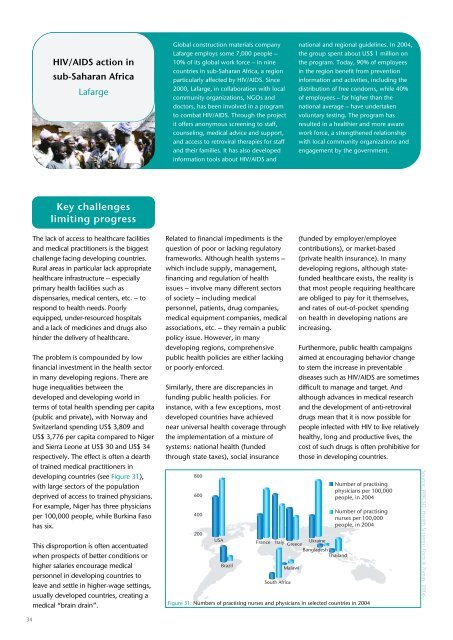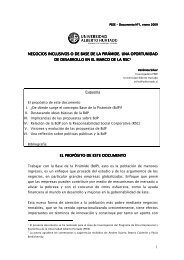Doing Business with the World - Mapeo de Promotores de RSE
Doing Business with the World - Mapeo de Promotores de RSE
Doing Business with the World - Mapeo de Promotores de RSE
Create successful ePaper yourself
Turn your PDF publications into a flip-book with our unique Google optimized e-Paper software.
HIV/AIDS action insub-Saharan AfricaLafargeGlobal construction materials companyLafarge employs some 7,000 people –10% of its global work force – in ninecountries in sub-Saharan Africa, a regionparticularly affected by HIV/AIDS. Since2000, Lafarge, in collaboration <strong>with</strong> localcommunity organizations, NGOs anddoctors, has been involved in a programto combat HIV/AIDS. Through <strong>the</strong> projectit offers anonymous screening to staff,counseling, medical advice and support,and access to retroviral <strong>the</strong>rapies for staffand <strong>the</strong>ir families. It has also <strong>de</strong>velopedinformation tools about HIV/AIDS andnational and regional gui<strong>de</strong>lines. In 2004,<strong>the</strong> group spent about US$ 1 million on<strong>the</strong> program. Today, 90% of employeesin <strong>the</strong> region benefit from preventioninformation and activities, including <strong>the</strong>distribution of free condoms, while 40%of employees – far higher than <strong>the</strong>national average – have un<strong>de</strong>rtakenvoluntary testing. The program hasresulted in a healthier and more awarework force, a streng<strong>the</strong>ned relationship<strong>with</strong> local community organizations an<strong>de</strong>ngagement by <strong>the</strong> government.Key challengeslimiting progressThe lack of access to healthcare facilitiesand medical practitioners is <strong>the</strong> biggestchallenge facing <strong>de</strong>veloping countries.Rural areas in particular lack appropriatehealthcare infrastructure – especiallyprimary health facilities such asdispensaries, medical centers, etc. – torespond to health needs. Poorlyequipped, un<strong>de</strong>r-resourced hospitalsand a lack of medicines and drugs alsohin<strong>de</strong>r <strong>the</strong> <strong>de</strong>livery of healthcare.The problem is compoun<strong>de</strong>d by lowfinancial investment in <strong>the</strong> health sectorin many <strong>de</strong>veloping regions. There arehuge inequalities between <strong>the</strong><strong>de</strong>veloped and <strong>de</strong>veloping world interms of total health spending per capita(public and private), <strong>with</strong> Norway andSwitzerland spending US$ 3,809 andUS$ 3,776 per capita compared to Nigerand Sierra Leone at US$ 30 and US$ 34respectively. The effect is often a <strong>de</strong>arthof trained medical practitioners in<strong>de</strong>veloping countries (see Figure 31),<strong>with</strong> large sectors of <strong>the</strong> population<strong>de</strong>prived of access to trained physicians.For example, Niger has three physiciansper 100,000 people, while Burkina Fasohas six.This disproportion is often accentuatedwhen prospects of better conditions orhigher salaries encourage medicalpersonnel in <strong>de</strong>veloping countries toleave and settle in higher-wage settings,usually <strong>de</strong>veloped countries, creating amedical “brain drain”.Related to financial impediments is <strong>the</strong>question of poor or lacking regulatoryframeworks. Although health systems –which inclu<strong>de</strong> supply, management,financing and regulation of healthissues – involve many different sectorsof society – including medicalpersonnel, patients, drug companies,medical equipment companies, medicalassociations, etc. – <strong>the</strong>y remain a publicpolicy issue. However, in many<strong>de</strong>veloping regions, comprehensivepublic health policies are ei<strong>the</strong>r lackingor poorly enforced.Similarly, <strong>the</strong>re are discrepancies infunding public health policies. Forinstance, <strong>with</strong> a few exceptions, most<strong>de</strong>veloped countries have achievednear universal health coverage through<strong>the</strong> implementation of a mixture ofsystems: national health (fun<strong>de</strong>dthrough state taxes), social insurance800600400200USABrazilFranceSouth AfricaMalawi(fun<strong>de</strong>d by employer/employeecontributions), or market-based(private health insurance). In many<strong>de</strong>veloping regions, although statefun<strong>de</strong>dhealthcare exists, <strong>the</strong> reality isthat most people requiring healthcareare obliged to pay for it <strong>the</strong>mselves,and rates of out-of-pocket spendingon health in <strong>de</strong>veloping nations areincreasing.Fur<strong>the</strong>rmore, public health campaignsaimed at encouraging behavior changeto stem <strong>the</strong> increase in preventablediseases such as HIV/AIDS are sometimesdifficult to manage and target. Andalthough advances in medical researchand <strong>the</strong> <strong>de</strong>velopment of anti-retroviraldrugs mean that it is now possible forpeople infected <strong>with</strong> HIV to live relativelyhealthy, long and productive lives, <strong>the</strong>cost of such drugs is often prohibitive forthose in <strong>de</strong>veloping countries.Italy UkraineGreeceBangla<strong>de</strong>shThailandNumber of practisingphysicians per 100,000people, in 2004Number of practisingnurses per 100,000people, in 2004Figure 31: Numbers of practising nurses and physicians in selected countries in 2004Source: WBCSD. Health Systems: Facts & Trends. 2006.34
















